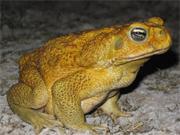 Longer-legged toads hop further faster© Ben Phillips
Longer-legged toads hop further faster© Ben PhillipsNeed to get somewhere fast? Growing longer legs is the cane toad's answer. The amphibian pest is accelerating its march across the Australian landscape, leaving a trail of ecological devastation.
Cane toads (Bufo marinus) were first introduced to the country 70 years ago in an attempt to control beetles. But the invader began eating other native fauna and spread across much of the country, wreaking havoc along the way (see 'The toads are coming!').
In the frog world, the cane toad is typically thought of as a slow plodder. But, in a report published in this week's Nature, researchers from the University of Sydney debunk this perception.
Midnight sprinters
By strapping tiny radiotransmitters to the toads' waists, the researchers revealed that they can travel at an alarming rate. The sprinters can move up to 1.8 kilometres a night and generally opt to travel along roads. "The toads are making it on their own - they aren't hitchhiking on the back of trucks as had been suspected," says Richard Shine, who led the research team.
"Toads are slow. They don't jump, they just kind of crawl. The idea that they are long-distance athletes is amusing and surprising," says David Skelly, an amphibian ecologist at Yale University in Connecticut.
So how are they making the distance so easily? Shine and his colleagues looked at preserved museum specimens and historical records and found that the toads have become 25% leggier and fivefold faster over a 60-year period.
Legging it
The researchers checked that the long legs really do translate into speedy crawling. Camping out in the wilderness in advance of the pests' invasive front, the researchers measured leg length as the newcomers arrived. They found that the first arrivals had legs stretching up to 45% of their total body length. Later waves of toads consisted of shorter-limbed kinfolk; frogs arriving a year later had legs measuring about 40% of their body length.
ADVERTISEMENT
Although insects and bacteria quickly adapt to changing circumstances, Skelly says this study is one of the first known examples of a vertebrate rapidly evolving in a new environment. "People have this deep-seated feeling that vertebrates don't evolve on of these sorts of timescales. But this work shows that it can happen," says Skelly. Cane toads typically start breeding at the age of one year, and can produce some 200,000 eggs in an average ten-year lifespan.
Accelerating cane toads are bad news for conservationists. "The toads will make it to Western Australia earlier than thought. We need to do something pretty quick," says Shine. Despite attempts to curtail the invaders, it looks - for now at least - as if the cane toad is outpacing such efforts.
Post a comment to this story by visiting our toadslegitacross_austr.html">newsblog.
-
References
- Phillips B. L., et al. Nature, 439. 803 (2006). | Article |
